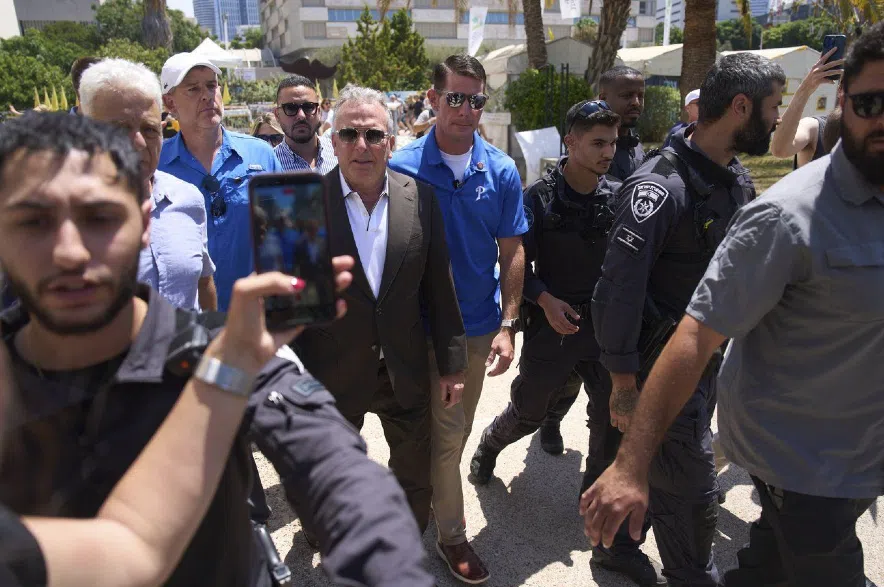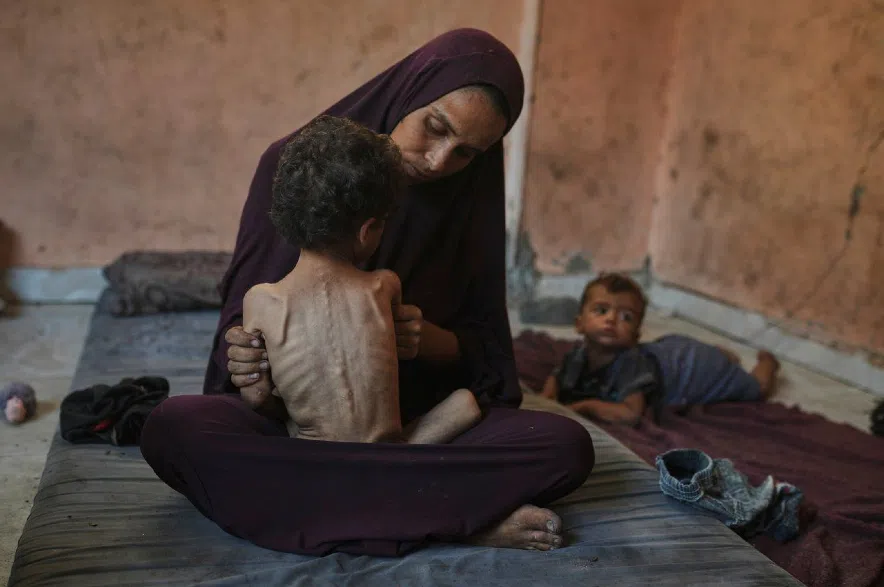DEIR AL-BALAH, Gaza Strip (AP) — Israeli forces opened fire near two aid distribution sites run by the Israeli-backed Gaza Humanitarian Foundation as crowds of hungry Palestinians again sought food, killing at least 10 people, witnesses and health workers said Saturday — a day after U.S. officials visited a GHF site and the U.S. ambassador called the troubled system “an incredible feat.”
Read more:
- Prime Minister Carney says Canada will recognize a Palestinian state
- Canada pledges $30M in Gaza aid, $10M for Palestinian Authority work toward statehood
- Tax data suggests lethal Canadian arms still being exported to Israel
Nearly a week has passed since Israel, under international pressure amid growing scenes of starving children, announced limited humanitarian pauses and airdrops meant to get more food to Gaza’s over two million people, who now largely rely on aid after almost 22 months of war.
But the United Nations, partners and Palestinians say far too little aid is still coming in, with months’ worth of supplies piled up outside Gaza waiting for Israeli approval.
Trucks that enter are mostly stripped of supplies by desperate people and criminal groups before reaching warehouses for distribution.
Experts this week said a “worst-case scenario of famine” was occurring in the besieged enclave. On Saturday, Gaza’s health ministry said seven more Palestinians had died of malnutrition-related causes over the past 24 hours, including a child.
Aid is “far from sufficient,” Germany’s government said via spokesman Stefan Kornelius.
Families of the 50 Israeli hostages still in Gaza fear they are going hungry too, and blame Hamas, after the militants released images of an emaciated hostage, Evyatar David.

White House special envoy Steve Witkoff arrives to meet families of hostages held captive in the Gaza Strip, at the plaza known as the hostages square in Tel Aviv, Israel, Saturday, Aug. 2, 2025. ( AP Photo/Ariel Schalit)
More deaths near U.S.-supported GHF sites
Near the northernmost GHF distribution site near the Netzarim corridor, Yahia Youssef, who had come to seek aid Saturday morning, described a panicked and grimly familiar scene.
After helping carry three people wounded by gunshots, he said he saw others on the ground, bleeding.
“It’s the same daily episode,” Youssef said.
Health workers said at least eight people were killed. Israel’s military said it fired warning shots at a gathering approaching its forces.
At least two people were killed in the Shakoush area hundreds of metres from where the GHF operates another site in the southernmost city of Rafah, witnesses said.
Nasser Hospital in nearby Khan Younis received two bodies and many injured.
Witness Mohamed Abu Taha said Israeli troops opened fire toward the crowds. He saw three people — two men and a woman — shot as he fled.
Israel’s military said it was not aware of any fire by its forces in the area. The GHF said nothing happened near its sites.
GHF says its armed contractors have only used pepper spray or fired warning shots to prevent deadly crowding.
Israel ’s military on Friday said it was working to make the routes under its control safer. Israel and GHF have claimed the toll has been exaggerated.
The GHF — backed by millions of dollars in U.S. support — launched in May as Israel sought an alternative to the U.N.-run system, which had safely delivered aid for much of the war but was accused by Israel of allowing Hamas to siphon off supplies.
Israel has not offered evidence for that claim and the U.N. has denied it.
From May 27 to July 31, 859 people were killed near GHF sites, according to a United Nations report published Thursday.
Hundreds more have been killed along the routes of U.N.-led food convoys. Hamas-led police once guarded those convoys and went after suspected looters, but Israeli fire targeted the officers.
Airdrops by a Jordan-led coalition — Israel, the UAE, Egypt, France, and Germany — are another approach, though experts say the strategy remains deeply inadequate and even dangerous for people on the ground.
“Let’s go back to what works & let us do our job,” Philippe Lazzarini, the head of the U.N. agency for Palestinian refugees, wrote Saturday on social media, calling for more and safer truck deliveries.
Airstrikes continue
An Israeli strike hit a group of Palestinians trying to secure aid trucks entering northern Gaza from the Israeli-controlled Zikim crossing, killing at least three people, said Fares Awad, head of the health ministry’s ambulance and emergency service.
Nasser Hospital said it received five bodies after two separate strikes on tents sheltering displaced people in Gaza’s south.
The health ministry’s ambulance and emergency service said an Israeli strike hit a house between the towns of Zawaida and Deir al-Balah, killing two parents and their three children.
Another strike hit a tent near a closed prison where the displaced have sheltered in Khan Younis, killing a mother and her daughter.
Israel’s top general Lt. Gen. Eyal Zamir warned that “combat will continue without rest” if hostages aren’t freed.
Hostage families push Israel to cut deal
U.S. President Donald Trump’s special envoy Steve Witkoff met with hostages’ families Saturday, a week after quitting ceasefire talks, blaming Hamas’ intransigence.
“I didn’t hear anything new from him. I heard that there was pressure from the Americans to end this operation, but we didn’t hear anything practical,” said Michel Illouz, father of Israeli hostage Guy Illouz.
He said he asked Witkoff to exert pressure and set a time frame but got “no answers.”
Protesters called on Israel’s government to make a deal to end the war, imploring them to “stop this nightmare and bring them out of the tunnels”
In part of Gaza City, displaced people who managed to return home found rubble-strewn neighborhoods unrecognizable. Most Palestinians in Gaza have been displaced, often multiple times, and are crowded into ever-shrinking areas considered safe.
“I don’t know what to do. Destruction, destruction,” said Mohamed Qeiqa, who stood amid collapsed slabs of concrete and pointed out what had been a five-story building. “Where will people settle?”
Israel has killed 60,400, sources say
The war began when Hamas attacked southern Israel on Oct. 7, 2023, killing around 1,200 people, mostly civilians.
Israel’s retaliatory offensive has killed more than 60,400 Palestinians, according to Gaza’s Health Ministry, which doesn’t distinguish between militants and civilians but says women and children make up over half the dead.
The ministry operates under the Hamas government. The U.N. and other international organizations see it as the most reliable source of data on casualties.
The ministry says 93 children have died from malnutrition-related causes in Gaza since the war began. It said 76 adults have died of malnutrition-related causes since late June, when it started counting adult deaths.
— by Wafaa Shurafa, Sam Metz And Samy Magdy in Deir el-Balah
Read more:











